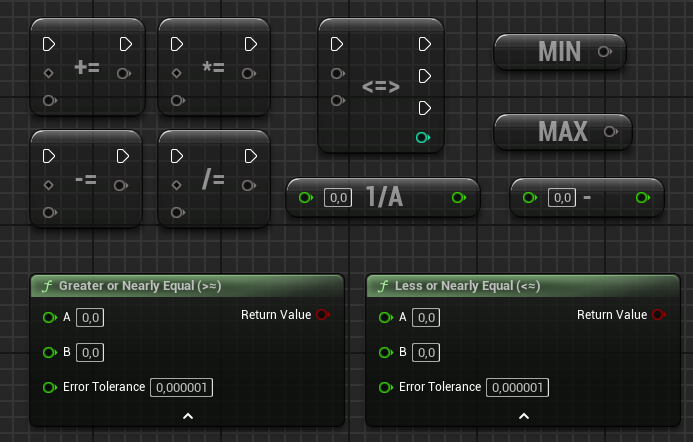
#
Math library
The math library of Blueprint Utilities provides new nodes to simplify scripting complex operations. The main goal of this library is to consolidate frequently used operations, such as the \frac{1}{x} function, into a single node, without duplicating native Unreal Engine nodes.
#
Node list
The MIN node return the smallest value of the selected type.

#
Ouput
- Value Wildcard
-
Return the smallest value of the selected type.
Right click on this pin to select manualy the type of the node. (see screen above)
The MAX node return the highest value of the selected type.

#
Ouput
- Value Wildcard
-
Return the highest value of the selected type.
Right click on this pin to select manualy the type of the node. (see screen above)
The Oposit (-) node return the input value times -1.

#
Input
- A Double: 0.0d
- The value to compute
#
Ouput
- Value Double
- The result of A \times -1
The Invert (1/x) node return 1 devided by the input value.

#
Input
- A Double: 0.0d
-
The value to compute.
If A is
0then the node return0and raise and division error.
#
Ouput
- Value Double
- The result of \frac{1}{A}
The Spaceship Operator <=> is the same as the operator from Perl, Ruby and C++20. Full explenation on the wikipedia page

#
Input
- Exec execution
- Main input pin of the node
- A Wildcard
- The first value to use in the three ways comparaison operator.
- B Wildcard
- The second value to use in the three ways comparaison operator.
#
Ouput
- Less execution
- Ouput pin triggered when
A < B. - Equal execution
- Ouput pin triggered when
A == B. - Greater execution
- Ouput pin triggered when
A > B. - Result int
- Result value of the operator returned to allow the user to use it without creating a new tempoary variable.
The += node behave like the C++ += operator. It take the B value and add it to A and set the new value to the variable A: A += B = A = A + B.

#
Input
- Exec execution
- Main input pin of the node.
- A Wildcard (by Ref)
- Reference to the variable you want to update.
- B Wildcard
- The value used as right-value in the operation.
#
Ouput
- Then execution
- Ouput execution pin.
- Value Wildcard
- The new value of
Aafter the assignment. Same as a fresh new get.
The -= node behave like the C++ -= operator. It take the B value and substract it to A and set the new value to the variable A: A -= B = A = A - B.

#
Input
- Exec execution
- Main input pin of the node.
- A Wildcard (by Ref)
- Reference to the variable you want to update.
- B Wildcard
- The value used as right-value in the operation.
#
Ouput
- Then execution
- Ouput execution pin.
- Value Wildcard
- The new value of
Aafter the assignment. Same as a fresh new get.
The *= node behave like the C++ *= operator. It take the B value and multiply with A and set the new value to the variable A: A *= B = A = A * B.

#
Input
- Exec execution
- Main input pin of the node.
- A Wildcard (by Ref)
- Reference to the variable you want to update.
- B Wildcard
- The value used as right-value in the operation.
#
Ouput
- Then execution
- Ouput execution pin.
- Value Wildcard
- The new value of
Aafter the assignment. Same as a fresh new get.
The /= node behave like the C++ /= operator. It take the A value and devide it with B and set the new value to the variable A: A /= B = A = A / B.

#
Input
- Exec execution
- Main input pin of the node.
- A Wildcard (by Ref)
- Reference to the variable you want to update.
- B Wildcard
- The value used as right-value in the operation.
#
Ouput
- Then execution
- Ouput execution pin.
- Value Wildcard
- The new value of
Aafter the assignment. Same as a fresh new get.
The Greater or Nearly Equal >≈ node return true if the A is superior to B or is nearly equal to B (using the error tolerance value): A >≈ B is same as A > (B - ErrorTolerance)

#
Input
- A Double
- The value that will be compared.
- B Double
- The value
Awill be compared to. - Error Tolerance Double
- The precision value is used to determine if A is considered equal to B.
#
Ouput
- Return Value Bool
- True if
A >≈ B.
The Less or Nearly Equal <≈ node return true if the A is less than B or is nearly equal to B (using the error tolerance value): A <≈ B is same as A < (B + ErrorTolerance)

#
Input
- A Double
- The value that will be compared.
- B Double
- The value
Awill be compared to. - Error Tolerance Double
- The precision value is used to determine if A is considered equal to B.
#
Ouput
- Return Value Bool
-
True if
A <≈ B.